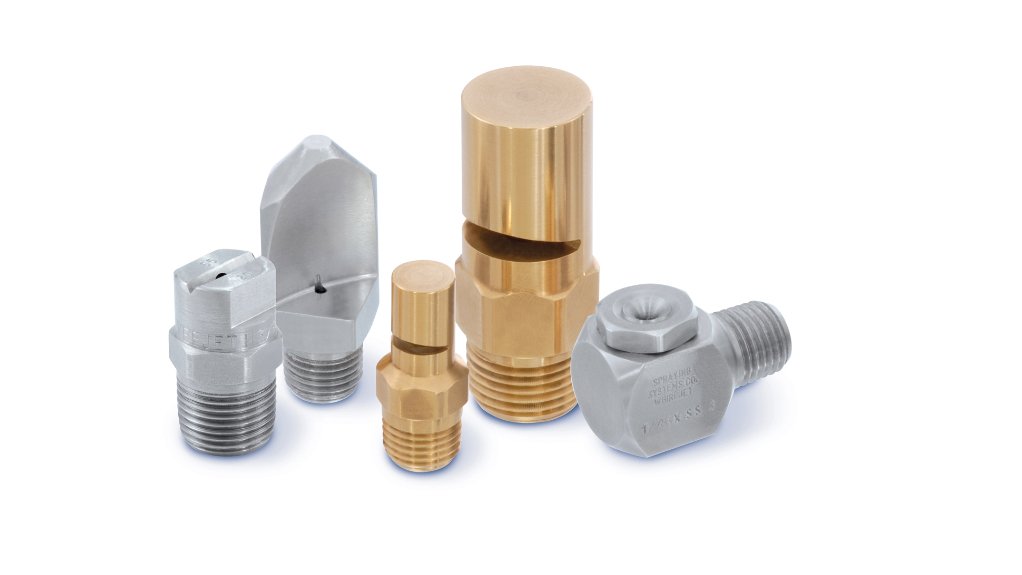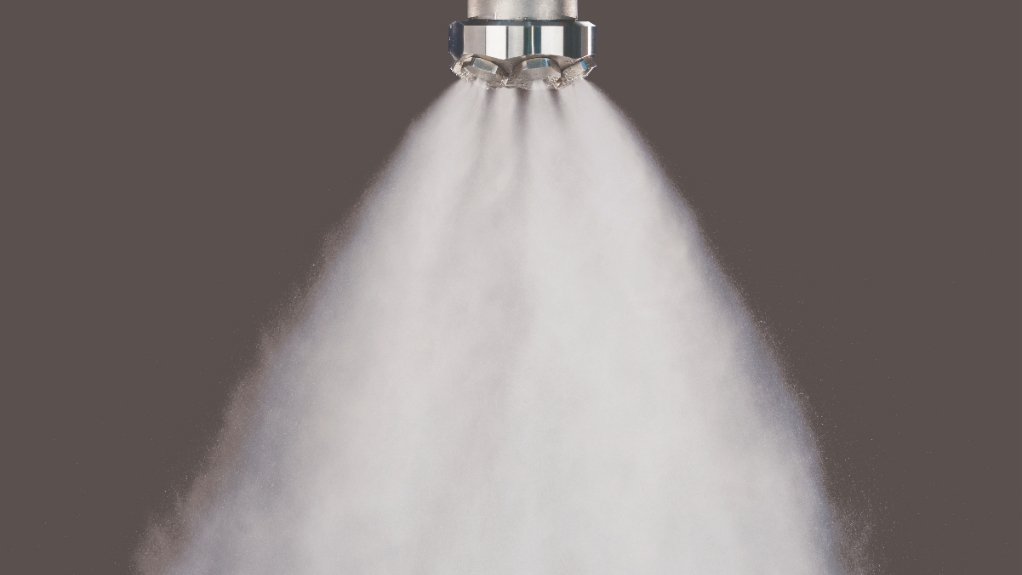Why Spray nozzles are essential for cooling processes
Spray nozzles are used to cool numerous industrial processes from stamping presses to freshly forged steel and from gas turbine inlets to power plant exhaust streams. But what is it about nozzles that make them an attractive cooling solution? It comes down to momentum, surface area, and vaporization.
Importance of vaporization
Vaporizing liquids takes a lot of energy. For water, it takes about five times more energy to vaporize water (transition from liquid to gas) than it would take to heat it from just-melted ice (at 0 °C) to just-about-to-boil liquid (at 100 °C). Of course, even if a liquid doesn’t vaporize it can still cool a surface. Spraying lubricating oil on a stamping press is going to cool it. But we can cool things far more effectively if we allow the liquid to vaporize. So why do sprays help with vaporization? By making the spray, we’ve created a lot more surface area between the liquid and the medium we’re trying to cool.
Surface area & heat transfer (cooling)
Why not just flood surfaces with water to cool them? There’s a limit to how much heat transfer (cooling) one can achieve with just a pool of boiling liquid. As water boils (vaporizes) it expands into a gas. If there’s enough of this expansion at the hot surface, we reach a point where the liquid never touches the surface directly. We now have a layer of gas insulating the hot surface. Spray droplets fly through the air with some momentum. Even if there’s a gas layer insulating the surface, momentum can carry droplets through.
Cooling hot gas flow
Of course, spray nozzles aren’t only used to cool surfaces. They can be used to cool gas flows as well. In many industrial applications such as power plant exhausts, a hot gas flow must be cooled before it can enter other equipment or is released into the atmosphere. Spray nozzles are a great choice for these sorts of applications. Because sprays have their own velocity, you can have just a few at strategic locations that still fill the duct with droplets – cooling all the gas. Strategic positioning of sprays in gas flows is key to preventing liquid droplets from hitting hot equipment causing fast evaporation. Droplet surface area in a gas flow is key to effective gas cooling.
Finally, one doesn’t have to go above the boiling point of water to benefit from spray cooling. Outdoor misters rely on vaporization to cool desert air while staying well below boiling. This principle is used to increase the power output of power generation gas turbines. Cooler air is denser. Therefore, there’s more oxygen that can enter the inlet and hence more fuel can be burned.
Spray cooling technology
Cooling plays a critical role in a wide range of applications across many industries. Spray technology is used and many of our spray nozzles provide the necessary spray cooling.
• WhirlJet® hollow cone spray nozzles – evaporative cooling in spray ponds and cooling towers, gas scrubbing, washing and cooling, water aerating and water cooling.
• VeeJet® flat spray nozzles – cooling and quenching, fire suppression/prevention, gas washing, washing/rinsing and water cooling.
• FullJet® Full Cone and CasterJet® spray nozzles – heat transfer cooling in steel mill operations.
• FloMax® Air Atomizing and HP FogJet® spray nozzles – gas cooling and conditioning operations.
• Lances and Precision Spray Injectors – gas cooling.
Cooling applications – sustainable solutions
Solid objects are typically cooled using spray nozzles and headers, especially in food processing and metalworking. Examples include cooling jam and jelly jars after steam sterilization, cooling and curing concrete blocks, and poultry grow-out house cooling. Here are a couple of examples of products that require cooling to optimize coverage and minimize waste.
• Case Study 1 Solution: Cast Iron Pipe Manufacturer Eliminates Rework and Saves US$40,000 per Month with New Spray System
• Product Feature: HHX FullJet® Full Cone Nozzles provide consistent spray distribution to ensure uniform cooling and high heat transfer in the steel industry. They are ideal for secondary cooling operations such as billets, blooms, rounds and slabs.
• Case Study 2 Solution: New Spray Nozzles save 2.7 Million Gallons of Water for Beef Processor.
• Product Feature: Quick FloodJet® Flat Spray Nozzles form a flat spray pattern that is evenly distributed from the center of the spray. The deflector surface enables wider spray angles compared to other flat spray nozzles.
Gas cooling
Gas cooling can be complicated and challenging due to high temperatures and extreme environments. It’s high imperative to determine the exact drop size required to achieve the desired cooling effect without wetting. The process stream and operating conditions have a big impact on spray performance, so Computational Fluid Dynamics (CFD) is often used to identify the best spray nozzle type, drop size, placement in the gas stream and spray direction.
Gas cooling is widely used in refineries, power plants and chemical processing. Typical applications include in-duct cooling, pollution abatement, emergency quench and more.
There are many other spray cooling applications we test and give solutions to our customers who run into challenges:
• Cooling steel in continuous casters
• Quenching metals after heat treating
• Roll cooling in steel mills
• Cooling food jars after processing
• Zoned cooling of roofing materials
• Evaporative cooling for livestock and poultry
• Cooling extruded PVC pipe
• Spray Ponds to cool water from heat exchanger
If you'd like to learn more about our cooling applications or want to discuss a specific application please contact us for your no charge plant audits.
Comments
Announcements
What's On
Subscribe to improve your user experience...
Option 1 (equivalent of R125 a month):
Receive a weekly copy of Creamer Media's Engineering News & Mining Weekly magazine
(print copy for those in South Africa and e-magazine for those outside of South Africa)
Receive daily email newsletters
Access to full search results
Access archive of magazine back copies
Access to Projects in Progress
Access to ONE Research Report of your choice in PDF format
Option 2 (equivalent of R375 a month):
All benefits from Option 1
PLUS
Access to Creamer Media's Research Channel Africa for ALL Research Reports, in PDF format, on various industrial and mining sectors
including Electricity; Water; Energy Transition; Hydrogen; Roads, Rail and Ports; Coal; Gold; Platinum; Battery Metals; etc.
Already a subscriber?
Forgotten your password?
Receive weekly copy of Creamer Media's Engineering News & Mining Weekly magazine (print copy for those in South Africa and e-magazine for those outside of South Africa)
➕
Recieve daily email newsletters
➕
Access to full search results
➕
Access archive of magazine back copies
➕
Access to Projects in Progress
➕
Access to ONE Research Report of your choice in PDF format
RESEARCH CHANNEL AFRICA
R4500 (equivalent of R375 a month)
SUBSCRIBEAll benefits from Option 1
➕
Access to Creamer Media's Research Channel Africa for ALL Research Reports on various industrial and mining sectors, in PDF format, including on:
Electricity
➕
Water
➕
Energy Transition
➕
Hydrogen
➕
Roads, Rail and Ports
➕
Coal
➕
Gold
➕
Platinum
➕
Battery Metals
➕
etc.
Receive all benefits from Option 1 or Option 2 delivered to numerous people at your company
➕
Multiple User names and Passwords for simultaneous log-ins
➕
Intranet integration access to all in your organisation























